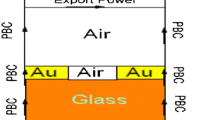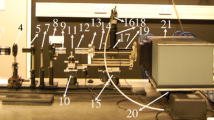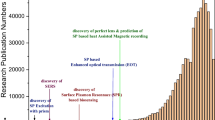Abstract
The present work investigates the effect of geometrical parameters of 1D nanograting on surface plasmon resonance (SPR) and plasmonic bandgap (PBG). The use of plasmonic grating device in various electronic devices is based on correct value of bandgap energy. For this purpose, various nanograting structures having regular periodic ridges in 1D has been modeled in the form of a gold film on glass substrate using finite element analysis in RFRF Module of COMSOL (Multiphysics) 5.3a licensed version. In the designed structures, firstly, the periodicity of the grating varied while keeping the slit width and film thickness constant. Furthermore, the thickness of the grating also varied while the periodicity and slit width is kept constant and transmitted mode for each structure is studied to find the suitable value of film thickness for optimizing the device. At the end, the slit width varied while keeping the periodicity and film thickness constant. Due to increase in slit width, the bandgap energy increases until slit width equals to nearly half of periodicity after this bandgap energy decreases and associated with the sinusoidal behavior of the device which support fundamental plasmonic mode. The increase in film thickness results a linear increase in bandgap energy as long as the film thickness is comparable to the skin depth of gold and plasmonic bandgap energy is high for smaller values of periodicity and decreases with increasing periodicity. Due to the ability to control the optical properties, the PBG is expected to have a major impact on technology.









Similar content being viewed by others
References
Wood RW (1902) XLII. On a remarkable case of uneven distribution of light in a diffraction grating spectrum. London Edinburgh Dublin Philosophical Magazine J Sci 4(21):396–402
Mie G (1908) Beiträge zur Optik trüber Medien, speziell kolloidaler Metallösungen. Ann Phys 330(3):377–445
Yablonovitch E (1993) Photonic band-gap structures. JOSA B 10(2):283–295
Scalora M, Dowling JP, Bowden CM, Bloemer MJ (1994) Optical limiting and switching of ultrashort pulses in nonlinear photonic band gap materials. Phys Rev Lett 73(10):1368–1371
John S (1987) Strong localization of photons in certain disordered dielectric superlattices. Phys Rev Lett 58(23):2486–2489
Alu A, Engheta N (2008) Plasmonic and metamaterial cloaking: physical mechanisms and potentials. J Opt A Pure Appl Opt 10(9):093002
Lim S et al (2007) Photocurrent spectroscopy of optical absorption enhancement in silicon photodiodes via scattering from surface plasmon polaritons in gold nanoparticles. J Appl Phys 101(10):104309
Kwon MK, Kim JY, Kim BH, Park IK, Cho CY, Byeon CC, Park SJ (2008) Surface-plasmon-enhanced light-emitting diodes. Adv Mater 20(7):1253–1257
Ditlbacher H et al (2005) Silver nanowires as surface plasmon resonators. Phys Rev Lett 95(25):257403
Atwater HA, Maier S, Polman A, Dionne JA, Sweatlock L (2005) The new “p–n junction”: plasmonics enables photonic access to the nanoworld. MRS Bull 30(5):385–389
Islam K, et al. (2013) Improved efficiency of thin film a-Si: H solar cells with Au nanoparticles. in Photovoltaic Specialists Conference (PVSC) IEEE 39th. 2013. IEEE
Ritchie R, Arakawa E, Cowan J, Hamm R (1968) Surface-plasmon resonance effect in grating diffraction. Phys Rev Lett 21(22):1530–1533
Chen Y et al (1983) One-dimensional long-range plasmonic-photonic structures. Solid State Commun 46:95–99
Heitmann D, Kroo N, Schulz C, Szentirmay Z (1987) Dispersion anomalies of surface plasmons on corrugated metal-insulator interfaces. Phys Rev B 35(6):2660–2666
Knoll W, Philpott MR, Swalen JD, Girlando A (1982) Surface plasmon enhanced Raman spectra of monolayer assemblies. J Chem Phys 77(5):2254–2260
Nash D et al (1995) Examination of the+ 1,− 1 surface plasmon mini-gap on a gold grating. J Mod Opt 42(1):243–248
Saito H, Yamamoto N (2015) Size dependence of bandgaps in a two-dimensional plasmonic crystal with a hexagonal lattice. Opt Express 23(3):2524–2540
Karademir E, Balci S, Kocabas C, Aydinli A (2014) Plasmonic band gap engineering of plasmon–exciton coupling. Opt Lett 39(19):5697–5700
Watanabe H, Honda M, Yamamoto N (2014) Size dependence of band-gaps in a one-dimensional plasmonic crystal. Opt Express 22(5):5155–5165
Iqbal T, Afsheen S (2016) Plasmonic band gap: role of the slit width in 1D metallic grating on higher refractive index substrate. Plasmonics 11(3):885–893
Oulton RF, Sorger VJ, Genov DA, Pile DFP, Zhang X (2008) A hybrid plasmonic waveguide for subwavelength confinement and long-range propagation. Nat Photonics 2(8):496–500
Nordlander P, Oubre C, Prodan E, Li K, Stockman MI (2004) Plasmon hybridization in nanoparticle dimers. Nano Lett 4(5):899–903
Javaid M, Iqbal T (2016) Plasmonic bandgap in 1D metallic nanostructured devices. Plasmonics 11(1):167–173
Raether H (1988) Surface plasmons on smooth surfaces, in Surface plasmons on smooth and rough surfaces and on gratings, Springer. p. 4–39
Raether H (1988) Springer tracts in modern physics. Vol. 111. Springer-Verlag
Sambles J, Bradbery G, Yang F (1991) Optical excitation of surface plasmons: an introduction. Contemp Phys 32(3):173–183
Ashcroft N and Mermin N (1976) Solid State Physics (Saunders College, Philadelphia). Google Scholar. p. 404
Iqbal T, Afsheen S (2016) Coupling efficiency of surface plasmon polaritons for 1D plasmonic gratings: role of under-and over-milling. Plasmonics 11(5):1247–1256
Palik ED (1984) Handbook of Optical-Constants. 1
Kvítek O et al (2013) Noble metal nanostructures influence of structure and environment on their optical properties. J Nanomater 2013:111
Benjamin P, Weaver C (1962) The adhesion of evaporated metal films on glass. Proc R Soc Lond A 261(1307):516–531
Ziman JM (1972) Principles of the theory of solids. Cambridge university press
Maier SA (2007) Plasmonics: fundamentals and applications. Springer Science & Business Media
Kocabas A, Senlik SS, Aydinli A (2008) Plasmonic band gap cavities on biharmonic gratings. Phys Rev B 77(19):195130
Li J et al (2003) Photonic band gap from a stack of positive and negative index materials. Phys Rev Lett 90(8):083901
Feng L, Lu MH, Lomakin V, Fainman Y (2008) Plasmonic photonic crystal with a complete band gap for surface plasmon polariton waves. Appl Phys Lett 93(23):231105
Lu C, Hu X, Yang H, Gong Q (2013) Integrated all-optical logic discriminators based on plasmonic bandgap engineering. Sci Rep 3:2778
Munir M, et al. (2018) Efficient biosensing through 1D silver nanostructured devices using plasmonic effect. Nanotechnology
Kolomenski A, Kolomenskii A, Noel J, Peng S, Schuessler H (2009) Propagation length of surface plasmons in a metal film with roughness. Appl Opt 48(30):5683–5691
Radko IP et al (2008) Efficiency of local surface plasmon polariton excitation on ridges. Phys Rev B 78(11):115115
Rosengart E-H, Pockrand I (1977) Influence of higher harmonics of a grating on the intensity profile of the diffraction orders via surface plasmons. Opt Lett 1(6):194–195
Lévêque G, Martin OJ (2006) Optimization of finite diffraction gratings for the excitation of surface plasmons. J Appl Phys 100(12):124301
Iqbal T (2015) Propagation length of surface plasmon polaritons excited by a 1D plasmonic grating. Curr Appl Phys 15(11):1445–1452
Iqbal T, et al. (2018) An optimal Au grating structure for light absorption in amorphous silicon thin film solar cell. Plasmonics p. 1–8
Author information
Authors and Affiliations
Corresponding authors
Ethics declarations
Conflict of Interest
The authors declare that they have no conflict of interest.
Rights and permissions
About this article
Cite this article
Iqbal, T., Khalil, S., Ijaz, M. et al. Optimization of 1D Plasmonic Grating of Nanostructured Devices for the Investigation of Plasmonic Bandgap. Plasmonics 14, 775–783 (2019). https://doi.org/10.1007/s11468-018-0857-5
Received:
Accepted:
Published:
Issue Date:
DOI: https://doi.org/10.1007/s11468-018-0857-5




